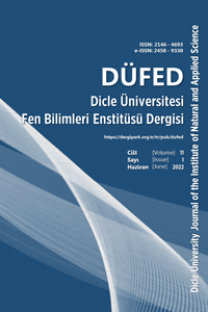N,N-Bis(salisiliden)-1,2-bis -(o - ve p - aminofenoksi)etandan elde edilen bazı geçişli metal komplekslerinin biyolojik aktiviteleri
Bu çal›flma için N,N -bis(salisiliden)-1,2-bis-(o-aminofenoksi)etan (L1) ve N,N -bis(salisiliden)-1,2-bis-(paminofenoksi)etan (L2) Schiff bazlar› sentezlendi. Bu ligandlardan da L1’in Cu(II), Ni(II), Zn(II) kompleksleri, L2’nin Cu(II), Co(II), Zn(II) kompleksleri elde edildi. Sentez sonras› elde edilen bu bileflikler, insanlarda yayg›n olarak görülen bulafl›c› bakteriler E. coli, Pseudomonas, Acinetobacter ve Staphylococcus’a karfl› etkinlikleri incelenmifltir. Her iki ligand›n da bak›r kompleksleri Staphylococcus’a karfl› etkili oldu¤u bulunmufltur. Staphylococcus, hastane çevresinde yayg›n olarak görülen patojenlerdendir. Bu yüzden bu ligandlar›n bak›r kompleksleri (L1-Cu ve L2-Cu) hastane hijyeninde kullan›fll› olabilece¤i düflünülmektedir.
Biological activities of some transition metal complexes derived from N,N -bis salicylidene -1,2-bis- o - and p - aminophenoxy ethan
The Schiff base ligands N,N -bis salicylidene -1,2-bis- o-aminophenoxy ethane L1 and N,N -bis salicylidene 1,2-bis- p-aminophenoxy ethane L2 were synthesized for this study. The Cu II , Ni II , Zn II complexesof L1 and the Cu II , Co II , Zn II complexes of L2 were obtained with various transition metal salts.These compounds were evaluated against to the common infectious bacteria in human such as E. coli,Pseudomonas, Acinetobacter and Staphylococcus strains. The copper complexes of both L1 and L2 were foundeffective against Staphylococcus strains. Staphylococcus strains are common pathogens in hospital environment.Thus, their copper complexes L1-Cu and L2-Cu may be useful in hospital hygiene
___
- 1. H. Temel, Ü. Çak›r, B. Otludil, H. ‹. U¤rafl, Synthesis, Synth. React. Inorg. Met.-Org. Chem., 31 (8) (2001) 1323-1337.
- 2. H. Temel, S. ‹lhan, M. fiekerci, R. Ziyadano¤ullar›, Spectrosc. Letters, 35 (2) (2002) 219-228.
- 3. M. R. Mahmoud, M. T. El-Haty, Inorg. Nucl. Chem., 42 (1980) 349-353.
- 4. H. Temel, MBCAC III 3rd Mediterranean Basin Conference on Analytical Chemistry, Antalya, Turkey, (2000) pp. 138.
- 5. H. Temel, M. fiekerci, Synth. React. Inorg. Met.-Org. Chem. 31 (5) (2001) 849-857.
- 6. H. Temel, S. ‹lhan, M. fiekerci, M. Synth. React. Inorg. Met.-Org. Chem. 32 (9) (2002) 1625-1634.
- 7. H. Temel, H. Hoflgoren, Transition Met. Chem. 27 (6) (2002) 609-612.
- 8. H. Temel, Ü. Çak›r, H. ‹. U¤rafl, M. Sekerci, J. Coord. Chem., 56 (11) (2003) 943-951.
- 9. D. F. Spooner, G. Sykes, Methods in Microbiology, J. R. Norris; D. W. Ribbons, (Ed.) Academic, Press Inc., London, 7B (1972) 277.
- 10. A. Scozzafava, L. Menabuoni, F. Mincione, G. Mincione, C.T. Supuran, Bioorg. Med. Chem. Lett, 11 (2001) 575-582.
- 11. A. Scozzafava and C. T. Supuran J. Med. Chem, 43 (2000) 3677-3687.
- 12. G. Alzuet, J. Casanova, J. Borras, S. Garcia-Granda, A. Gutierrez-Rodriguez, C. T. Supuran, Inorganica Chimica Acta, 273 (1998) 334-338.
- 13. C. T. Supuran, A. Scozzafava Eur. J. Med. Chem, 35 (2000) 867-874.
- 14. D. R. Williams, The Metals of Life, Van Nostrand, London (1971).
- 15. R. J. P. William, Quart. Rev, 24 (1970) 331-340.
- 16. R. J. P. William, Bioinorganic Chemistry, American Chemical Society, Washington (1971).
- 17. C.T. Supuran, A. Scozzafava, L. Menabuoni, F. Mincione, F. Briganti and G. Mincione, Metal-Based Drugs 6 (1999) 67-76.
- 18. J. M. Pratt, Inorganic Chemistry of Vitamin B, Academic Press, London (1970).
- 19. S. K. Shapiro and F. Schlenk, Transmethylation and Methionine Biosynthesis, University of Chicago Press, Chicago (1965).
- 20. J. M. Walshe, Brit. J. Hospit. Med. 6 (1970) 45-52.
- 21. E. Ochial, Coord. Chem. Rev. 3 (1968) 49-60.
- 22. F. Frieden, Sci. Amer 2 (1968) 1021.
- 23. R. J. P. William, Chem. Rev. 1 (1968) 13-34.
- 24. E.Sinn, C. M. Harris, Coord. Chem. Rev. 4 (1969) 391-403
- ISSN: 2146-4693
- Yayın Aralığı: Yılda 2 Sayı
- Başlangıç: 2012
- Yayıncı: Dicle Üniversitesi
Sayıdaki Diğer Makaleler
İki çekirdekli rutenyum II aren komplekslerinin ketonların transfer hidrojenasyonuna uygulanması
Nermin MERİÇ, Cezmi KAYAN, Murat AYDEMİR, Yusuf Selim OCAK, Akın BAYSAL, Hamdi TEMEL
Prevalence of house dust mites in houses, hotels and student dormitories of Diyarbakır province
Medeni AYKUT, Ömer Köksal ERMAN, Salih DOĞAN
Hamdi TEMEL, Hasan UÇMAK, Salih PAŞA, Mustafa A. YILMAZ, Salih HOŞOĞLU
Gülşah Saydan KANBEROĞLU, Raciye MERAL
NaCl -BaCl2 -H2O üçlü su-tuz sisteminin +50o'de incelenmesi
İhsan ALACABEY, Vedat ADIGÜZEL, Arzu YENİGÜN, Vedat TAVŞAN, Ali Rıza KUL, İhsan ALACABEY
Ahmet TOMBAK, Yusuf Selim OCAK, Tahsin KILIÇOĞLU
Cezmi KAYAN, Nermin MERİÇ, Murat AYDEMİR, Akın BAYSAL, Hamdi TEMEL
